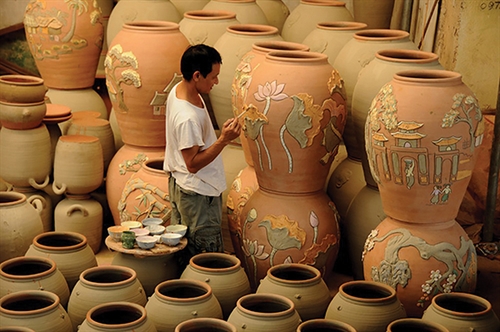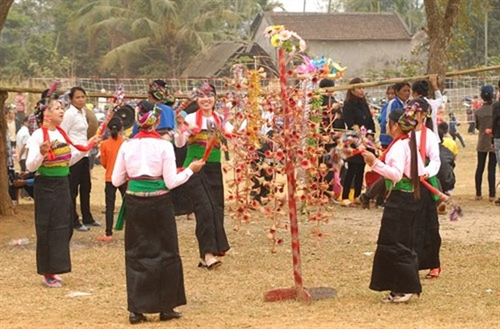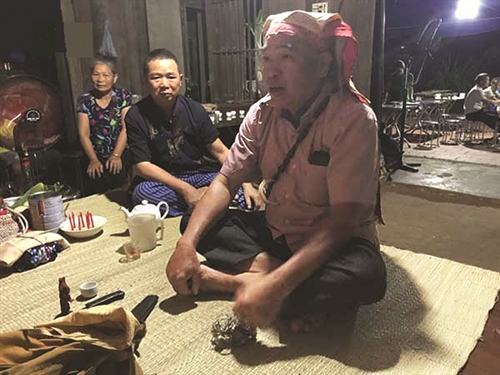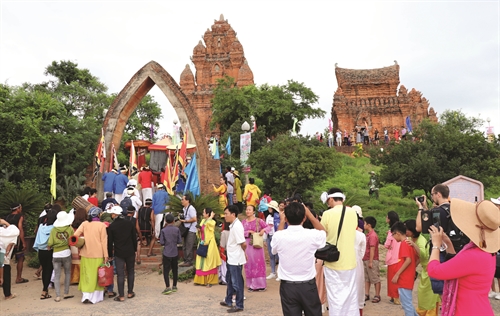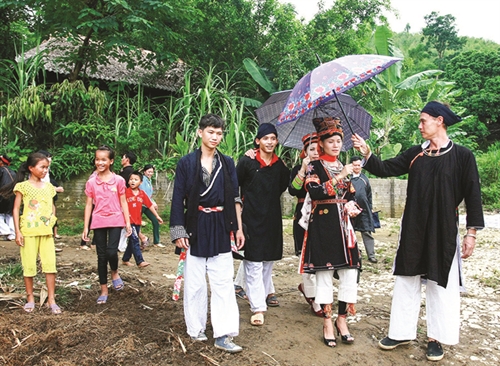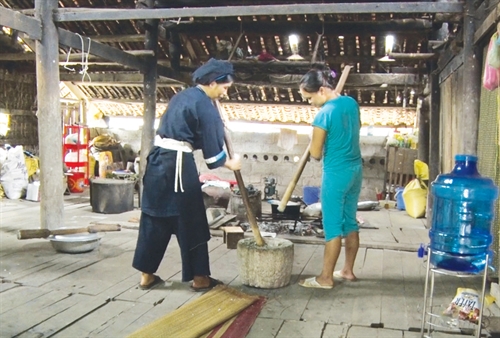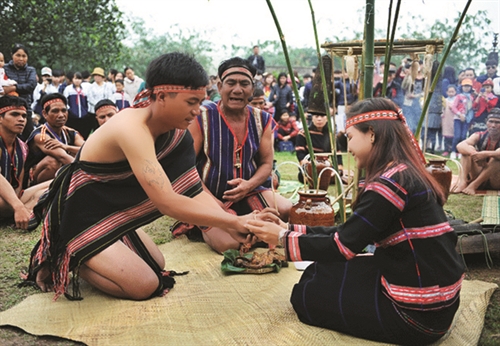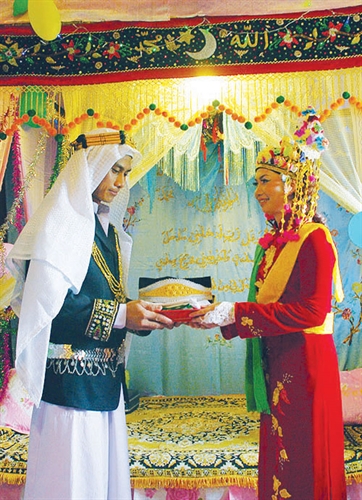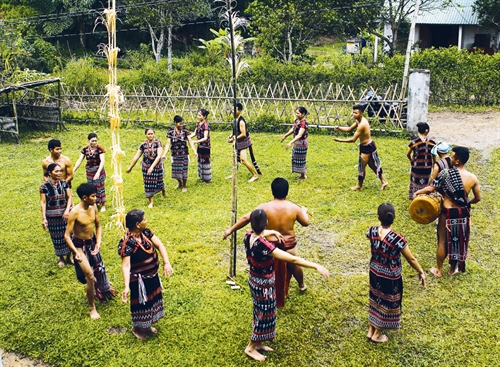Ta Thi Tam, M.A.
Institute of Anthropology
Vietnam Academy of Social Sciences
The Hmong Xanh, “blue” Hmong, is one of four sub-groups of Hmong people living mostly in Van Ban district of the northern mountainous province of Lao Cai.
According to the sub-group’s customary law, marriages among people of the same clan are prohibited but exogamy is gradually accepted in the sub-group. The Hmong Xanh, especially those following the sub-group’s traditional belief, often seek partners among those who share the same belief with them.
 |
| Bride Ly Thi Vien and groom Vang A Tru on their wedding day__Photo: https://baolaocai.vn/ |
For the Hmong Xanh, an ideal partner is a wholesome, virtuous and assiduous person. A good wife must know how to grow flax, weave cloth, sew and embroider while a perfect husband must be proficient at farming, carpentry, and rattan and bamboo weaving, and a good flute or panpipe player and singer. Hmong Xanh youths often find love through meetings at village kermesses, festive events and New Year celebrations. Hmong Xanh men play flutes, panpipes or reeds to express their souls and find their soulmates.
A Hmong Xanh wedding goes through three main ceremonies, namely proposal, wedding and re-visit, which are characterized by traditional indigo costumes worn by the bride and groom, their relatives and guests, and flute playing by the groom’s matchmakers, making Hmong Xanh wedding rites so attractive and unique as compared with other sub-groups of Hmong people.
The Hmong Xanh are quite free in love. If a Hmong Xanh boy falls for a girl and wishes to marry her, he will ask his parents to send matchmakers to the girl’s house to propose marriage. These matchmakers, who must be smooth tongued and good flute players, are accompanied by a maternal or paternal uncle of the future groom, several groomsmen and the groom himself. Setting out in the twilight of a good date chosen by the boy’s family, they bring the offerings including a rooster, a hen, a bottle of wine and some pipe tobacco. The uncle and matchmakers must carry along umbrellas which are clamped under their arms with the umbrella tips pointing to the front. If the matchmakers see a snake or hear a muntjac’s sound on the way to the girl’s home, their trip is believed to be unlucky.
Arriving at the girl’s home, the matchmakers stop at the gate, singing a song to ask the host to open the gate and, when standing in front of the house’s entrance door, they play the flutes three times for the latter to open the door. Entering the house, the matchmakers sing another song, asking the host to give them some water to wash their faces and feet and a place to hang their umbrellas which is usually the back wattle in the middle part of the house. The two matchmakers then offer the host pipe tobaccos and sing the most important song to inform the host of the boy’s marriage proposal.
After hearing the matchmakers’ song, the girl’s father asks the girl’s opinion. If the girl rejects the proposal, her mother will offer the groom’s delegation three glasses of wine. If the girl accepts the proposal, her family will set the table and serve each person a full bowl of rice. The groom’s delegation will then spend the night at the bride’s house. The next morning, the bride’s family sends two matchmakers to discuss marriage exactions and other wedding details with the groom’s matchmakers. The four matchmakers will compare the birthdates of the girl and the boy to see whether they will go well with each other. They will kill a chicken to foresee the marriage by seeing the fowl’s feet. The couple is believed to be happy if the chicken’s toes huddle together.
The wedding day will be agreed upon by the two families but must not fall on the rainy season. The groom’s procession to escort the bride comprises two male and one female matchmakers, an elderly who deeply understands their traditional customs and practices, a young lady, usually the groom’s sister or cousin who has not yet married, a person carrying the wedding offerings, a groomsman, and the groom. Particularly, the groom will have his face fully covered with red pigments as red color is believed to bring luck and peace to the couple.
When the procession arrives at the bride’s house, a maternal uncle of the bride will receive the wedding offerings. The groom’s matchmakers take out pipe tobacco to invite the bride’s relatives and pour two large bowls of wine to say the reason of their visit. After that, the groom is invited to pray in front of the ancestor altar of the bride’s family. The procession has dinner and stays overnight at the bride’s home.
At noon of the next day, the groom’s matchmakers ask for permission from the bride’s family to bring the bride to her new home. The bride whose face is covered with a long black scarf is taken by her future sister-in-law while the groom leaves the house through its main entrance door. Before setting out, the bride must not turn back to see her parents as the Hmong Xanh believe that such act might lead to unhappy marriage. The bride’s family offers wine to the groom’s family while the matchmakers of both families and the bride’s relatives and friends sing a song to say goodbye to the bride and procession.
Arriving at the groom’s home, the bride is taken directly to the bridal chamber. The groom’s representatives offer pipe tobacco and tea to the bride’s delegation who stay overnight at the groom’s house. The next day, the groom’s family gives pig legs to the bride’s delegation to carry home.
Three days after the wedding ceremony, the groom’s family invites a sorcerer to organize a ritual in front of the family’s house to admit the bride’s spirit to the family. The offerings to the family’s ancestors include one egg, three incense sticks and two chickens. As soon as the ritual finishes, the egg is boiled and given to the bride to eat.
The day after the ritual, the newlyweds and the groom’s parents bring a male pig, two chickens and a knife to the bride’s family to thank the latter for permitting the marriage.-
